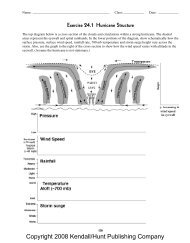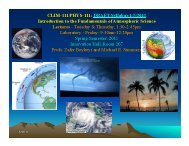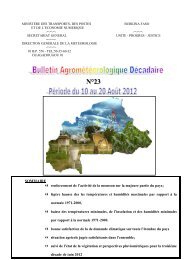Copyright 2008 Kendall/Hunt Publishing Company - CAMP
Copyright 2008 Kendall/Hunt Publishing Company - CAMP
Copyright 2008 Kendall/Hunt Publishing Company - CAMP
Create successful ePaper yourself
Turn your PDF publications into a flip-book with our unique Google optimized e-Paper software.
Name: _____________________________________________ Class: ____________ Date: ____________<br />
PGF = Pressure Gradient Force<br />
CF = Coriolis Force<br />
FR = Frictional Force<br />
GR = Gravitational Force<br />
Exercise 7.1 Forces in the Atmosphere<br />
Place letters on the blanks in each statement to make the statement correct.<br />
1. The _________________ is zero at the equator and increases with latitude.<br />
2. The _________________ acts to accelerate air horizontally from rest.<br />
3. The _________________ can change the direction air moves, but not its speed.<br />
4. The _________________ is strongest near the earth’s surface and decreases in importance at higher altitudes.<br />
5. The strength of the _________________ is visualized on a surface map by isobars.<br />
6. In the Northern Hemisphere, the _________________ always acts opposite the direction of air motion, but the<br />
_________________ always acts to the right of the air motion.<br />
7. For weather applications, the magnitude of the _________________ acting on any air parcel can be considered<br />
constant throughout the troposphere.<br />
8. The _________________ acts to reduce the speed of air.<br />
9. Except for very close to the surface, _________________ acts primarily through the mixing of parcels of air<br />
moving at different speeds.<br />
10. The _________________ is an apparent force associated with the rotation of the Earth.<br />
11. The _________________ is always directed toward lower values of pressure.<br />
<strong>Copyright</strong> <strong>2008</strong> <strong>Kendall</strong>/<strong>Hunt</strong> <strong>Publishing</strong> <strong>Company</strong><br />
51
<strong>Copyright</strong> <strong>2008</strong> <strong>Kendall</strong>/<strong>Hunt</strong> <strong>Publishing</strong> <strong>Company</strong>
Name: _____________________________________________ Class: ____________ Date: ____________<br />
Exercise 7.2 The Horizontal Pressure Gradient Force<br />
1. At each of the large black dots on the map above, draw an arrow emerging from the dot to indicate the direction<br />
of the pressure gradient force (PGF). Adjust the length of your arrows so that a long arrow indicates a<br />
relatively strong PGF and a short arrow indicates a relatively weak PGF. Arizona has been done for you.<br />
2. What is the average value of the pressure gradient between the high-pressure center on the West Coast<br />
(1033 mb) and the low-pressure center in Colorado (988 mb)? Assume the distance between these two points<br />
is approximately 1500 km.<br />
3. Salt Lake City, in northern Utah about halfway between the high and low, is approximately 20 kilometers in<br />
diameter. What is the approximate pressure change (in mb/km) across Salt Lake City?<br />
<strong>Copyright</strong> <strong>2008</strong> <strong>Kendall</strong>/<strong>Hunt</strong> <strong>Publishing</strong> <strong>Company</strong><br />
53
<strong>Copyright</strong> <strong>2008</strong> <strong>Kendall</strong>/<strong>Hunt</strong> <strong>Publishing</strong> <strong>Company</strong>
Name: _____________________________________________ Class: ____________ Date: ____________<br />
Exercise 7.3 The Geostrophic Wind<br />
Assume that the flow represented on the 500 mb map above is in geostrophic balance.<br />
1. Draw an arrow showing the speed and direction of the geostrophic wind at each of the four points indicated<br />
on the map. The “tail” of each arrow should be at the point and the length of the arrow should be proportional<br />
to wind speed.<br />
2. Draw a second arrow at each point that represents the pressure gradient force (PGF). Again, the tail of the<br />
arrow should be at each point, the arrow should point in the direction the force acts, and the length of the<br />
arrow should represent the relative strength of the PGF. Label the arrow “PGF.”<br />
3. Do the same as in (2), but for the Coriolis Force. Label the arrow “CF.”<br />
<strong>Copyright</strong> <strong>2008</strong> <strong>Kendall</strong>/<strong>Hunt</strong> <strong>Publishing</strong> <strong>Company</strong><br />
55
<strong>Copyright</strong> <strong>2008</strong> <strong>Kendall</strong>/<strong>Hunt</strong> <strong>Publishing</strong> <strong>Company</strong>
Name: _____________________________________________ Class: ____________ Date: ____________<br />
Exercise 7.4 Fronts and the Jetstream<br />
1. The maps on the left are surface maps depicting positions of frontal boundaries and low- and high-pressure<br />
centers. The maps on the right depict wind speed at 300 mb, with the light shading indicating winds exceeding<br />
70 knots and the dark shading indicating winds exceeding 100 knots. Match the surface map with the jet<br />
stream.<br />
Map A matches Map _________________<br />
Map B matches Map _________________<br />
Map C matches Map _________________<br />
2. How did you determine the matching?<br />
<strong>Copyright</strong> <strong>2008</strong> <strong>Kendall</strong>/<strong>Hunt</strong> <strong>Publishing</strong> <strong>Company</strong><br />
57
<strong>Copyright</strong> <strong>2008</strong> <strong>Kendall</strong>/<strong>Hunt</strong> <strong>Publishing</strong> <strong>Company</strong>







